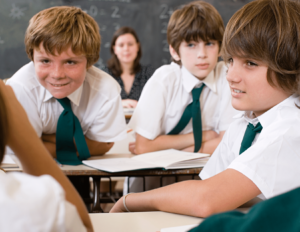Here is a great article from Dr. Stuart Shanker on Self Regulation from http://www.cea-ace.ca/education-canada/article/self-regulation-calm-alert-and-learning
It is a great read and really great for understanding a child potential difficulty with learning may be a result of the environment they are in.
Self-Regulation: Calm, Alert, and Learning*
There is a growing awareness among developmental scientists that the better a child can self-regulate, the better she can rise to the challenge of mastering ever more complex skills and concepts. In the simplest terms, self-regulation can be defined as the ability to stay calmly focused and alert, which often involves – but cannot be reduced to – self-control. The better a child can stay calmly focused and alert, the better he integrates the diverse information coming in from his different senses, assimilates it, and sequences his thoughts and actions.
For someone who thinks that self-regulation is really just a matter of a child’s getting in control of his negative emotions, there is very little difference between self-regulation and compliance. But, unlike compliance based on punishment, self-regulation nurtures the ability to cope with greater and greater challenges because it involves arousal states, emotions, behavior, and – as the child grows older – thinking skills.
Two recent Government of Ontario publications, With our Best Future in Mind[1] and Every Child Every Opportunity,[2] have brought self-regulation to the fore of that province’s early learning initiative. This thematic core reflects a growing awareness among developmental scientists that the better a child can self-regulate, the better she can rise to the challenge of mastering ever more complex skills and concepts.[3] But what exactly is self-regulation, and why is it so important for learning?
In the simplest terms, self-regulation can be defined as the ability to stay calmly focused and alert, which often involves – but cannot be reduced to – self-control. The idea that self-regulation and self-control are one and the same is surprisingly ancient, dating back to Plato. All of the great treatises on pedagogy, from Erasmus and Comenius, through Locke and Rousseau, right up to Watson and Skinner, can be said to have been inspired by Plato’s vision of emotions and appetites as “wild horses” that need to be restrained by Reason. Given the power of these elemental forces, says this vision, Reason has to be strengthened so as to keep hold of the reins.[4]
Five-domain Model
Now, to be sure, what developmental scientists refer to today as effortful control (e.g., being able to inhibit one’s impulses or ignore distractions) is a critical element of self-regulation. But to get a sense of the full array of processes involved in self-regulation,one need only turn to a standard resource tool like Baumeister & Vohs’ Handbook of Self-Regulation, which includes at least five distinct definitions presented in the various chapters: [5]
- “The ability to attain, maintain and change one’s level of arousal appropriately for a task or situation”
- “The ability to control one’s emotions”
- “The ability to formulate a goal, monitor goal-progress, adjust one’s behaviors”
- “The ability to manage social interactions, to co-regulate”
- “To be aware of one’s academic strengths and weaknesses, and have a repertoire of strategies to tackle day-to-day challenges of academic tasks”
Not surprisingly, each of these definitions reflects the interests of the different sub-disciplines represented in the Handbook (viz., temperament, emotion development, cognitive development, social development, and educational theory). What makes the topic of self-regulation such a rich area of study, however, is the awareness that each of these elements influences all of the others. That is, self-regulation should be viewed through the model of dynamic systems theory, according to which the effect of any level is dependent on the rest of the system, making all factors potentially interdependent and mutually constraining.[6]
The better a child can stay calmly focused and alert, the better he integrates the diverse information coming in from his different senses, assimilates it, and sequences his thoughts and actions.
Indeed, we can introduce still more complexity if we view self-regulation in terms of Uri Bronfenbrenner’s ecological model, for it is clear that we can talk about the self-regulation of a family, a classroom, a school, a community, even a society. But for the purposes of this article, just looking at the level of the child presents more than enough of a challenge!
The five levels operating in the above definitions are:
- Biological (e.g., how well the child regulates her arousal states)
- Emotional (e.g., how well the child monitors and modifies her emotional responses)
- Cognitive (e.g., how well the child can sustain and switch her attention; inhibit impulses; deal with frustration, delay, distractions; sequence her thoughts)
- Social (e.g., the child’s mastery of rules of appropriate behaviour; how well the child can co-regulate and thereby develop prosocial attributes)
- Reflective thinking skills
The key to understanding the complex nature of self-regulation is to recognize the bottom-up and top-down interactions of all these levels, which together facilitate a child’s ability to take in and process information. The better a child can stay calmly focused and alert, the better he integrates the diverse information coming in from his different senses, assimilates it, and sequences his thoughts and actions. What the five-domain model of self-regulation tells us is that this ability to stay self-regulated when confronted with novelty involves all of these levels: arousal states, emotions, behaviour, and – as the child grows older – thinking skills.
Self-regulation vs. Compliance
To illustrate this point, I might contrast two Grade 1 classes that I recently visited. In the first, the children were all sitting quietly at their desks. The teacher was reading them a story and pausing every few minutes to ask a question about what she had just read. A couple of hands would shoot up and the selected child would briefly answer while all the rest remained quiet. At the end of the story there was a brief commotion as the children got out their workbooks to practice cursive writing, but quiet soon reigned once again.
The other class was almost the exact opposite. Children were scattered around the room working in small groups, some on the floor, others at tables. One group was playing with a projector, making stencils of trapeze artists for shadows. Another was making a circus mobile out of pipe cleaners. A third group was using sticks and seashells to make a circus. (Perhaps I should mention that the class had visited a circus the week before). A fourth group was standing at a flip-chart, practicing reading skills. It certainly wasn’t quiet in this room, and there was lots of movement.
Now, one of these classes demonstrated more self-regulation than the other: Can you guess which? Yes, it was the class with the hubbub, and if we can understand the reason, it will take us a long way towards answering our opening questions about the meaning and importance of self-regulation.
As I looked carefully at the first class, I noticed that several of the children weren’t paying the least bit of attention, while a number were listening off and on. Only a few of the children were raptly engaged throughout: the same children, as it happens, who put up their hands every time the teacher asked a question. A couple of times the teacher tried to engage a different child to answer, but he tuned her out, seeming not to hear her.
What was so striking in the second class was that all of the children were fully engrossed in what they were doing, and they stayed this way the entire time I was there. Not a single child was daydreaming or withdrawn. The teacher and Early Childhood Educator (ECE) visited each group for five or ten minutes, responding to questions and offering up suggestions. All of the children immediately engaged with the teacher or ECE when she came to talk with them, yet the activities themselves remained self-directed.
Another striking contrast between the two classes was in the way anger was handled. There was one sudden outburst in each class while I was present. In the first class, the teacher was very firm in making clear that such behaviour would not be tolerated and that the child would be sent into the hallway if he couldn’t control himself. As a result, the child almost instantly became quiet. In the second class, shouting broke out in one of the groups, which brought the ECE scurrying over. But instead of raising her own voice, she asked the children what the problem was and was gradually able to get each of them to explain what had happened. The children then returned to their activity and remained quietly engrossed for the rest of the class.
What the contrast between these two classes is telling us is that self-regulation can be every bit as much a matter of up-regulating as of down-regulating one’s emotions and desires.
For someone who thinks that self-regulation is really just a matter of a child’s getting in control of his negative emotions, there is very little difference between these two examples: that is, between self-regulationand compliance. Certainly this was the case historically, as generation after generation used punishment and reward to keep students quiet. The problem is that a child who is only quiet because of fear of the consequences, or because she is hoping to obtain some reward, isn’t developing the ability to cope with greater and greater challenges. In fact, we know from abundant data that the overuse of punitive measures to elicit compliance is a predictor of externalizing problems, while the overuse of rewards can have a dampening effect on motivation.[7]
Asking Why
Ultimately, what the contrast between these two classes is telling us is that self-regulation can be every bit as much a matter of up-regulating as of down-regulating one’s emotions and desires. It goes without saying that in many cases a child has trouble paying attention because he doesn’t find the material interesting, but the five-domain model directs us to consider why this should be the case.
Often, when children don’t exert the effort required to follow a lesson, it isn’t because they are bored, or because they have some sort of congenital “motivation deficit”, but because – for one reason or another – they struggle to take in and process the information. Some children may be too excited or restless, but rather than jump to the conclusion that they have an innate “attention deficit”, we need to understand the underlying factors that have made it difficult for them to make sense of the information being presented.
Whatever the circumstances, we always want to ask ourselves why a child is having a problem staying calmly focused and alert, applying the different levels listed above to try to understand the source of the problem. For example, many children have trouble paying attention because they are anxious, and in many cases the cause of their anxiety might be a hypersensitivity to various kinds of stimuli. The more anxious the child, the more pronounced becomes the hypersensitivity, setting off a vicious circle effect.
Conversely, a hyposensitive child may not notice a stimulus unless it is fairly strong. Closely related to this are problems in sensory processing. For example, a child might be a little slower in processing auditory information. In fact, I wondered whether this might have been the reason that several of the children in the first class weren’t attending to the story – not because they weren’t interested in the material, but because they were having trouble keeping up with the pace at which the teacher was reading – a pace she unconsciously tailored to the capacities of the small group of children who were keenly attentive.
Similarly, I wondered whether all of the children in the second class were so absorbed in their activities not only because the activities were actively self-selected, but also because of an unconsciously operating self-selecting bias: that is, were children drawn to a particular activity – playing with the light projector, for example – because of a particular sensory strength or need? If so, it raises another question: how might a teacher capitalize on this proclivity to strengthen the child’s weaker senses?
For many children, the problem isn’t that they can’t stay regulated per se, but that in order to do so, they adopt a strategy that blocks out social interaction. These children find co-regulation difficult, whether with their teacher or their peers, and they may find it difficult to control their behaviour in social situations because they are over-loaded by the presence of other children. But here, too, we need to ascertain the reasons for these problems, which might trace back to problems in sensory regulation; or problems in attachment; problems in limbic system reactivity; or even problems in understanding the significance of nonverbal cues. Faced with the challenge of keeping in control of her classroom, a teacher may not have the luxury of exploring the underlying causes of the child’s disruptive behaviour. But there will be such causes, and if we resort to medications to control the child’s behaviour, we will have done nothing to address these underlying causes.
Indeed, the very notion of control is problematic. The medieval view of controlling negative emotions was framed almost entirely in terms of acquiring the willpower and discipline needed to keep one’s unruly appetites and emotions in check. And for this purpose, fear was seen as a prime motivator. But just as a child can be overwhelmed by his sensations, he can also be overwhelmed by his emotions unless he develops the capacity to understand and express them. Far from trying to get him to repress his anger, we need to allow him to feel and talk about this emotion. In some ways the very idea that a child needs to learn how to inhibit his appetites and impulses is worrying; for the real goal of focusing on self-regulation is to help the child learn how to manage his internal states, however difficult we ourselves might find his outbursts.
Conclusion
In short, self-regulation serves as a lens for understanding a child, his individual strengths and the areas that need work, and thus as a lens for understanding what we hope to accomplish in our teaching practices. Take our first example of the teacher reading to her class: we know that this is a wonderful activity, but why? What exactly are we hoping to accomplish?
This is where thinking in terms of self-regulation is particularly useful, for it moves us away from seeing the activity as an end in itself – where, for example, the point of the exercise is simply to get children to learn how to sit quietly and listen – to thinking about the underlying capacities that we are hoping to develop. Reading to a class and asking them questions about the story is such a powerful way to help children develop their comprehension and sequencing skills, learn how to think multi-causally and in shades of grey, and open up to new realms of experience and emotional connectedness. But then, such an exercise is only effective if the child is engaged.
Which brings us to the last of our contrasts between the two classes. One small group in the second class involved four children listening to their teaching assistant reading a story about Madeline at the circus. Far from sitting quietly, the children were all shouting with glee at various points as they related something in the story to their own experience at the circus. And no one else in the room was in the least bit bothered, for they too were fully absorbed in their own learning adventures.
EN BREF – Les scientifiques spécialisés en développement prennent de plus en plus conscience du fait que plus un enfant peut faire preuve d’autorégulation, mieux il peut relever le défi qui consiste à maîtriser des compétences et concepts. L’autorégulation peut être définie, simplement, comme la capacité de maintenir un intérêt calme et alerte, ce qui comprend souvent – mais pas exclusivement – l’autocontrôle. Plus l’enfant peut conserver un intérêt calme et alerte, mieux il intègre les divers renseignements provenant de ses différents sens; il les assimile et établit un ordre séquentiel pour ses réflexions et actions. Pour quelqu’un qui croit que l’autorégulation se résume à la maîtrise par l’enfant de ses émotions négatives, il y a peu de différence entre l’autorégulation et la conformité. Mais contrairement à la conformité axée sur la punition, l’autorégulation développe la capacité de faire face à des difficultés de plus en plus grandes, car elle concerne les états d’éveil, les émotions, le comportement et – lorsque l’enfant vieillit – les compétences de réflexion.
[1] C. Pascal, “With Our Best Future in Mind: Implementing Early Learning in Ontario,” Report to the Premier (Government of Ontario, 2009). Retrieved November 12, 2009.
[2] Government of Ontario (2010), Every Child Every Opportunity.
[3] Stuart Shanker and Roger Downer, “Enhancing the Potential in Children (EPIC),” in Critical Issues in Policy in the Early Years, ed. H. Denise (London, Sage: in press).
[4] For a much fuller treatment of this topic, see Stuart Shanker, “Emotion Regulation Through the Ages,” in Moving Ourselves, eds. T. Racine and A. Foolen (in press).
[5] R. F. Baumeister and K. D. Vohs, Handbook of Self-regulation: Research, Theory, and Applications (New York: Guilford Press, 2004).
[6] A. Fogel, B. J. King and S. Shanker, Human Development in the 21st Century: Visionary Policy Ideas from Systems Scientists (Council on Human Development, 2008).
[7] See M. R. Lepper, S. Sethi, D. Dialdin and M. Drake, “Intrinsic and Extrinsic Motivation: A Developmental Perspective,” Developmental Psychopathology: Perspectives on Adjustment, Risk, and Disorder, 1997: 23-50; E. L. Deci, R. Koestner and R. M. Ryan, “A Meta-analytic Review of Experiments Examining the Effects of Extrinsic Rewards on Intrinsic Motivation,” Psychological Bulletin 125, no. 6 (1999): 627-68, 692-700; M. R. Lepper, G. Sagotsky, J. L. Dafoe and D. Greene, “Consequences of Superfluous Social Constraints: Effects on Young Children’s Social Inferences and Subsequent Intrinsic Interest,” Journal of Personality and Social Psychology 42, no. 1 (1982): 51-65; A. Kruglanski, “Issues in Cognitive Social Psychology,” The Hidden Cost of Reward: New Perspectives on the Psychology of Human Motivation (Lawrence Erlbaum, 1978).



